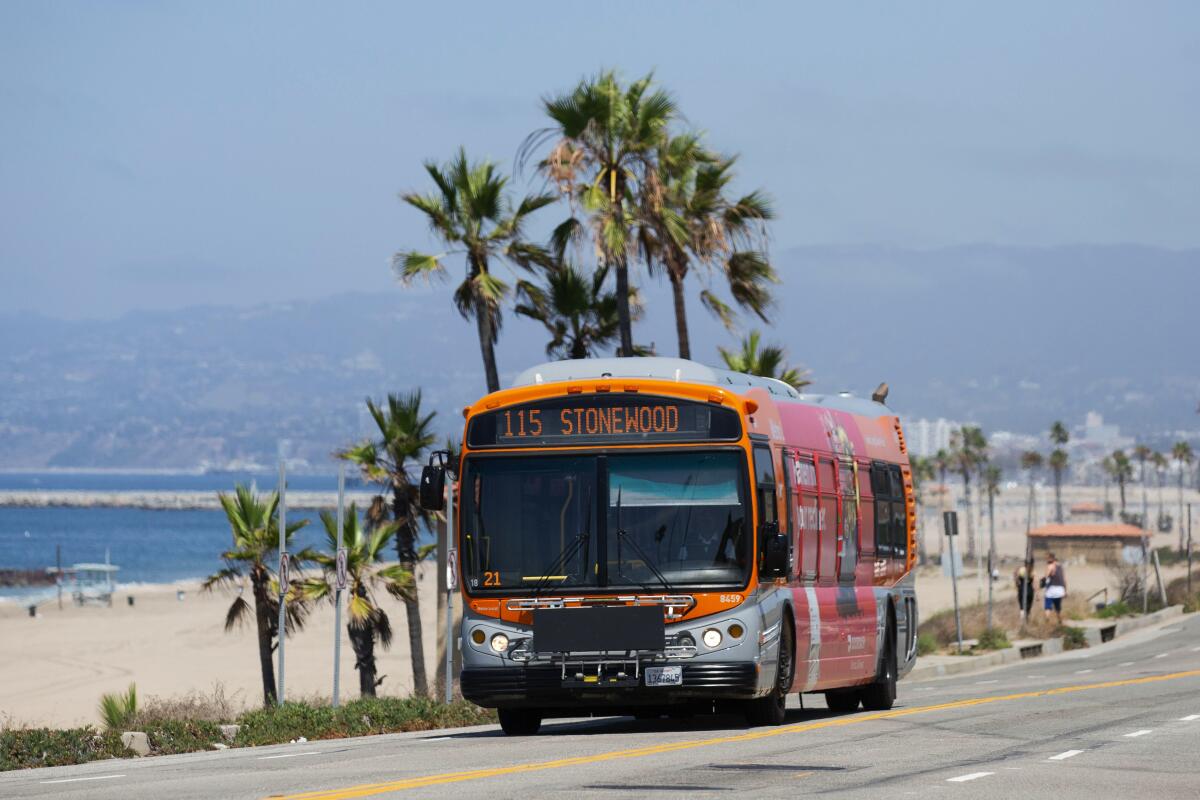Metro bus fares are back on Monday. What you need to know

- Share via
The pandemic may be surging again, but one of its few perks — free Metro bus rides — is ending. Starting Monday, the L.A. Metropolitan Transportation Authority is resuming fare collection on bus lines and again requiring passengers to enter through the front door, by the driver — and the fare box.
Since March 2020, passengers haven’t been expected to pay a fare on bus trips and they’ve boarded only at the back of the bus as part of L.A. Metro’s attempt to keep riders a safe distance from drivers and one another.
Prior to the pandemic, L.A. Metro made an estimated $250 million to $300 million from fares. After thousands of Angelenos rode free for last year, Metro said in a press release that it was reinstituting fare collection because “your fares help keep our system running.”
But fares aren’t returning to their pre-pandemic level just yet. Here’s what you need to know about riding with L.A. Metro.
How much will it cost?
From Monday through July 22, multi-ride passes for people not enrolled in other fare-assistance programs will be 50% off:
- 1 day (24 hours of unlimited rides): $3.50
- 7 days: $12.50
- 30 days: $50
One-way fares for rail and most bus lines will remain $1.75; the fare will still be $2.50 for certain express buses. Transfers within two hours to other Metro lines will continue to be free.
How can you save money?
Metro has been exploring the idea of operating the bus and rail lines without charging riders, but it is still looking for alternative ways to fund its operations. So far it’s launched only a two-year pilot project offering free rides for K-12 and community college students.
The GoPass Fareless Pass Program allows students to ride free pretty much whenever, wherever. Participating schools and districts include:
- Alliance College Ready Charter Schools
- Birmingham Community Charter High School
- California School of the Arts — San Gabriel Valley (Duarte)
- Cathedral High School
- Centinela Valley Unified
- Culver City Unified School District
- Da Vinci RISE High School
- El Camino Real Charter High School
- El Rancho Unified
- Environmental Charter Schools
- ICEF Public Schools
- Los Angeles Academy of the Arts and Enterprise
- LA Alliance Charter Schools
- Los Angeles Unified School District
- New West Charter School
- North Valley Military Institute
- Santa Monica-Malibu Unified
- Scholarship Prep
- TIME Community Schools
- Youth Build Charter Schools
To find out if your school is participating in the program, visit Metro’s website.
Meanwhile, low-income Angelenos can obtain discounted pass cards through Metro’s Low-Income Fare is Easy program. To be eligible, your household income has to be no more than half the median family income for L.A. County (that translates to $41,400 for a single individual or $59,100 for a family of four). You can simply attest on the application that you’re qualified, or you can submit documents that prove your eligibility, such as Medi-Cal or food stamp records.
Those already enrolled in the LIFE program will pay about 50% off the discounted regular rates through late July. A seven-day pass will cost $6.50, and a 30-day pass $26.
For new LIFE enrollees, L.A. Metro is offering a 90-day period of free rides.
More to Read
Sign up for Essential California
The most important California stories and recommendations in your inbox every morning.
You may occasionally receive promotional content from the Los Angeles Times.











